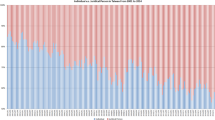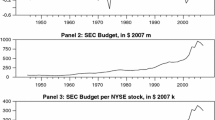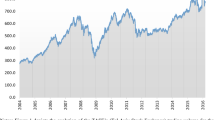Abstract
The main purpose of this study is to examine the relationship between financial opacity, investor protection and stock market behavior for sixteen countries. We use the 1995 CIFAR corporate disclosure ratings and the 2006 World Bank investor protection index to measure a country’s relative level of financial transparency and legal protection for investors. The return behavior of each country is examined using numerous time series tests such as serial correlation, Markov chain, runs, duration dependence and variance ratio tests. We found that the results show no significant differences between high and low disclosure countries. However, high disclosure countries appear to be associated with a lower level of stock market volatility. Cox proportional hazard test results indicate that extreme returns (positive and negative) are more likely in low disclosure countries.
Similar content being viewed by others
Notes
Bloomberg, March 30, 2010.
Further information on the investor protection index can be obtained from the World Bank Doing Business Data website at www.doingbusiness.org.
The CIFAR index was last published in 1995, so we were not able to obtain an updated CIFAR index ranking for 2006.
Refer to Bushman et al. (2004) for a detailed description and evaluation of the CIFAR index.
1995 CIFAR disclosure ranking provides the ranking for forty countries. We exclude Zimbabwe and Nigeria from our study due to the unavailability of the stock price data from MSCI.
MSCI Indices are constructed on a uniform basis across countries. The indices are constructed so as not to include stocks with multiple-listings on foreign stock exchanges. This eliminates the problem of double counting stocks. In addition, the MSCI indices do not include the stock of companies that are non-domiciled and that have high cross-ownership. Firms that have high reciprocal ownership provide a continuous flow of information among firms, making access to inside information easier and publicly available information less useful. Further details on the construction of MSCI indicies can be obtained from http://www.msci.com.
In their paper examining the predictability of crashes in emerging market currency markets, Kumar and Moorthy (2003) define a currency market crash as a monthly decrease of 10% or more. Similarly, Bordo and Wheelock (2007) define stock market booms as any 3-year or longer period where the average annual rate of increase in the real stock index is at least 10%.
The Mann–Whitney Rank test is more robust than a t-test because it does not require normality. The test statistic is calculated as: n a n b + ((n a(n a + 1))/2)) − T a, where T a is the observed sum of ranks for the high disclosure group and n a and n b are the number of countries in the high and low disclosure group, respectively. No ties occur in our data.
Under the null hypothesis of no serial correlation, the Ljung-Box portmanteau test statistics is defined as \( Q_{LB} = T(T + 2)\sum\limits_{J = 1}^{K} {{\frac{{r_{j}^{2} }}{T - j}}.} \) It has an asymptotic chi-square distribution with j degrees of freedom where r j is the jth order autocorrelation coefficient estimate. The Q-statistic at lag j is a test statistic for the null hypothesis that there is no autocorrelation in the return series up to order j.
A detailed description of the mechanics of the runs test is given in the “Technical appendix”.
The details of the duration dependence test are given in the “Technical appendix”.
The Third Order Markov chain test is described in the “Technical appendix”.
See original paper of McQueen and Thorley (1994) for full detail of the derivation of this equation. This condition, however, does not hold for runs of negative returns because rational expectations bubbles cannot be negative.
References
Allison PD (1995) Survival analysis using the SAS system: a practical guide. SAS Institute, Cary
Barth JR, Trimbath S, Yago G (2003) Before the Enron collapse: what corporate CFO’s around the world said about the status of accounting and disclosure practices. Rev Pac Basin Financ Mark Policies 6(4):433–440
Barton J, Waymire G (2004) Private incentives and investor protection under unregulated financial reporting. J Account Econ 38(1–3):65–116
Beck T, Demirguc-Kunt A, Levine R (2003) Law, endowments and finance. J Financ Econ 70(2):137–181
Bordo MD, Wheelock DC (2007) Stock market booms and monetary policy in the twentieth century. Fed Reserv Bank St Louis Rev 89(2):91–122
Botosan CA (1997) Disclosure level and the cost of equity capital. Account Rev 72:323–349
Brockman P, Chung D (2008) Investor protection, adverse selection, and the probability of informed trading. Rev Quant Financ Acc 30:111–131
Bushman R, Piotroski J, Smith A (2004) What determines corporate transparency? J Account Res 42(2):207–252
Caprio G (1998) Banking on crises: expensive lessons. Res Financ Serv 10:3–20
Chan K, Mcqueen G, Thorley S (1998) Are there rational speculative bubbles in Asian stock markets? Pac Basin Financ J 6:125–151
Cheng CS, Collins D, Huang HH (2006) Shareholder rights, financial disclosure and the cost of equity capital. Rev Quant Financ Acc 27:175–204
Chiou WJP, Lee AC, Lee CF (2010) Stock return, risk and legal environment around the world. Int Rev Econ Financ 19:95–105
CIFAR (1995) International accounting and auditing trends, 4th edn. Center for International Financial Analysis and Research, Princeton
Cochrane J (1988) How big is the random walk in GNP? J Pol Econ 96:893–920
Cox DR (1972) Regression models and life tables with discussion. J R Stat Soc Series B 34(2):187–220
Cox DR, Oakes D (1984) Analysis of survival data. Chapman and Hall, London
DeFond M, Hung M, Trezevant R (2007) Investor protection and the information content of annual earnings announcements: international evidence. J Account Econ 43(1):37–67
Diamond DW, Verrecchia RE (1991) Disclosure, liquidity, and the cost of capital. J Financ 46:1325–1359
Eaton T, Nofsinger J, Weaver D (2007) Disclosure and the cost of equity in international cross-listing. Rev Quant Financ Acc 29:1–24
Elliot R, Jacobson P (1994) Commentary: cost and benefits of business information disclosure. Account Horiz 8:80–96
Fama EF (1970) Efficient capital markets: a review of theory and empirical work. J Financ 25(2):383–417
Frost CA, Ramin KP (1997) Corporate financial disclosure: a global assessment. Int Account Financ Handb
Gelos RG, Wei SJ (2002) Transparency and international investor behavior. National Bureau of Economic Research Working Paper 9260, Cambridge, MA, pp 1–37
Glosten L, Milgrom P (1985) Bid, ask and transaction prices in a specialist market with heterogeneously informed traders. J Financ Econ 26:71–85
Greenspan A (1998) Statement to the United States Senate Committee on the Budget. Fed Reserv Bull 84:936–938
Gregoriou G (2003) Hedge fund survival lifetimes. J Asset Manage 3:237–252
Halely UC (2000) Corporate governance and restructuring in East Asia: an overview. J Econ 13:225–251
Healy P, Palepu K (2001) Information asymmetry, corporate disclosure and the capital markets: a review of the empirical disclosure literature. J Account Econ 31(1–3):405–440
Henebry KL (1996) Do cash flow variables improve the predictive accuracy of a Cox proportional hazards model for bank failure? Q Rev Econ Financ 36:395–409
Hope O (2003) Accounting policy disclosures and analysts’ forecasts. Contemp Account Res 20(2):295–321
Huang B (1995) Do Asian stock market prices follow random walks? Evidence from the variance ratio test. Appl Financ Econ 5:215–256
Kanodia C, Lee D (1998) Investment and disclosure: the disciplinary role of periodic performance reports. J Account Audit Financ 13(1):33–55
Karemera D, Ojah K, Cole J (1999) Random walks and market efficiency tests: evidence from emerging equity markets. Rev Quant Financ Acc 13(2):171–188
Kumar M, Moorthy U (2003) Predicting emerging market currency crashes. J Empir Financ 10(4):427–455
Lang M, Lundholm R (1993) Cross-sectional determinants of analyst ratings of corporate disclosures. J Account Res 31:246–271
Lang MH, Lundholm RJ (1996) Corporate disclosure policy and analyst behavior. Account Rev 71:467–492
Lee CF, Lee KW, Yeo GHH (2009) Investor protection and convertible debt design. J Bank Financ 33:985–995
Lo AW, MacKinlay AC (1988) Sock market prices do not follow random walks: evidence from a simple specification test. Rev Financ Stud 1:897–916
Long D, Payne J, Feng C (1999) Information transmission in the Shanghai equity market. J Financ Res 22(1):29–45
MacDonald SB (1998) Transparency in Thailand ‘s 1997 economic crisis: the significance of disclosure. Asian Survey 38:688–703
McQueen G, Thorley S (1994) Bubbles, stock returns, and duration dependence. J Financ Quant Anal 29:379–401
Moeller T, Molina CA (2003) Survival and default of original issue high-yield bonds. Financ Manage 32:83–107
Stulz RM, Williamson R (2003) Culture, openness, and finance. J Financ Econ 70:313–349
Vishwanath T, Kaufmann D (2001) Toward transparency: new approaches and their application to financial markets. World Bank Res Obs 16:41–47
White EN (1990) The stock-market boom and crash of 1929 revisited. J Econ Perspect 4:67–83
Zeff SA (1972) Foreign accounting principles in five countries. Stipes, Champaign
Acknowledgments
We wish to thank Manferd Peterson, Kathy Farrell, Richard DeFusco, and Mary McGarvey for helpful comments, and Benjamin Kim for support and guidance. We acknowledge the helpful comments on an earlier version of the paper from the participants at the 2002 Financial Management Association meeting and participants in a finance workshop at the University of Nebraska-Lincoln.
Author information
Authors and Affiliations
Corresponding author
Technical appendix
Technical appendix
1.1 Non-parametric runs test
The runs test examines the likelihood of sequential dependence among series of the same type, such as an increase or decrease (run up and down) without requiring normality of the return distribution. For a “run up”, a positive sign is assigned if the return in a sequence is greater than the preceding return, whereas a negative sign is assigned if the return in the sequence is smaller than the preceding return.
The Z-statistic for the null hypothesis that the real return for a particular country is random, implying weak-form efficiency, is computed as follows:
where M is the actual numbers of runs and E(M) is the expected number of runs which is calculated as:
where N is the number of observation and σ 2(M) is the variance of M runs which is computed as:
The Z test statistic has a standard normal distribution.
1.2 Duration dependence test
The duration dependence methodology developed by McQueen and Thorley (1994) examines the hazard rate (h i) for positive and negative runs. The hazard rate is defined as the probability of obtaining a negative return (ε t < 0) given a sequence of i prior positive returns (ε t−i > 0). The hazard rate, in the presence of negative duration dependence,
To apply the duration dependence test, the stock returns of each country are transformed into run lengths of positive and negative returns. The hazard function (h i ), defined as h i ≡ Prob(I = i∣I ≥ i), represents the probability that a specific run ends at length i, provided that it lasts until length i. Specifically, the presence of a bubble indicates that the hazard rates for runs of positive return should decrease as the length of the run increases, h i+1 < h i for all i.Footnote 16 The log likelihood of the hazard function is defined as follows:
The functional form for the hazard function is based on the logistic transformation of the log of i.
where N i is the number of completed runs of length i in the sample. M i and Q i are the numbers of completed and partial runs with length greater than i. The sample estimated hazard rate\( (\hat{h}_{i} ) \) for length i is derived from maximizing the log likelihood function in (5) which yields
The null hypothesis of no bubble or a constant hazard rate requires that β = 0. The alternative hypothesis of a bubble suggests that the probability of a run of positive return ending should decrease with the length of the run (i.e. a decreasing hazard rate, β < 0).
Duration dependence tests are performed by maximizing the log likelihood function with respect to α and β. The hazard function is estimated as a Logit regression in which the independent variable is the log of the current run length and the dependent variable is 1 if the run ends in the next period and 0 if it does not. Under the null hypothesis of no bubble (β = 0), the likelihood ratio test (LRT) is asymptotically distributed χ2 with one degree of freedom.
1.3 Third-order Markov chain
Under the Markov chain technique, the random walk process requires that transition probabilities from one state to another are equal, regardless of the prior return sequence. If the returns have unequal transition probabilities then it is likely that the return series follow a non-random walk pattern.
To test the random walk hypothesis, a two-state Markov chain process {I t } can be formulated by letting I = 1 if the returns are positive (R t > 0) and I = 0 if the returns are negative (R t < 0). Therefore, the finite Markov process {I t } can be defined as follows:
If the positive and negative returns are random, the probability of observing positive or negative returns should not depend on the prior sequence. To test for the randomness of the returns series, the transition counts and transition probabilities are formed based on the behavior of process {I
t
}. For a two-state third-order Markov chain, the transition counts and transition probabilities vary depending on the returns of three prior states. The transition counts (N
ijk
and M
ijk
) and probabilities (λ
ijk
) are defined as  N
000
represents the number of observations in state 0 0 0 0. M
000
represents the number of observations in state 0 0 0 1. For example, the transition probabilities (λ
000
) can be defined as follows:
N
000
represents the number of observations in state 0 0 0 0. M
000
represents the number of observations in state 0 0 0 1. For example, the transition probabilities (λ
000
) can be defined as follows:
where λ 000 is the probability that a negative return will persist in the current period given a sequence of three negative returns and therefore (1 − λ 000 ) is the probability that a sequence of three negative returns will revert to a positive return in the current period. If the returns series are random or symmetric, the probability of observing a negative or positive return in the current period should be similar and independent of what happened in the prior states. The null hypothesis of a random walk is tested by imposing the restriction on transition probabilities:
The maximum likelihood estimators λ ijk ,
and their asymptotic variances,
are derived from the following log likelihood function
Given the estimates of the transition probabilities, the likelihood ratio test (LRT) is used to test the null hypothesis of equal transition probabilities. The LRT is
1.4 Variance ratio test
The variance ratio test developed by Cochrane (1988) has been employed in numerous studies as an alternative test of the random walk hypothesis (see for example, Lo and MacKinlay 1988; Huang 1995; Long et al. 1999). Cochrane (1988) showed that if the data generating process is a random walk, the variance of k-period return should be equal to k times the variance of the one-period return. Therefore, under the null hypothesis of a random walk process, the expected value of the variance ratio (VR(k)) for all lags k should be unity. The variance ratio is defined as:
where ρ(j) is the sample autocorrelation coefficient of the one period return at lag j and k is the number of autocorrelations used in the calculation of VR(k). A VR(k) significantly lower (higher) than one indicates the presence of negative (positive) serial correlation in the return series.
Under the assumption of homoscedasticity, the asymptotic variance of VR(k) statistic can be defined as follows:
where T is the sample size. With the assumption of homoskedasticity, the VR(k) statistics under the null hypothesis of a random walk have a normal distribution. The Z(k) test statistic is estimated as:
Rights and permissions
About this article
Cite this article
Jirasakuldech, B., Dudney, D.M., Zorn, T.S. et al. Financial disclosure, investor protection and stock market behavior: an international comparison. Rev Quant Finan Acc 37, 181–205 (2011). https://doi.org/10.1007/s11156-010-0200-5
Published:
Issue Date:
DOI: https://doi.org/10.1007/s11156-010-0200-5




